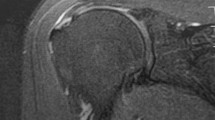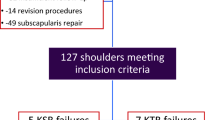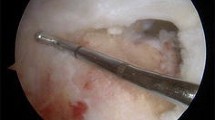Abstract
Purpose
The aim of this study was to compare the functional and structural outcomes of 2 techniques for double-row, suture-bridging cuff repair.
Methods
A consecutive series of 73 patients who underwent arthroscopic, double-row, suture-bridge primary rotator cuff repair of full-thickness supraspinatus tear were evaluated. Thirty-eight shoulders were repaired by the arthroscopic, tied, suture-bridging technique (group A), and 35 shoulders by knot-less bridging with suture tape material (group B). Constant scores, pain, range of motion, strength, and complications were measured after a minimum follow-up period of 12 months post-operatively. Structural integrity of the repairs was evaluated systematically by either magnetic resonance imaging or computed tomography arthrography.
Results
Median follow-up after surgery was 29 (23–32) months in group A, and 21 (12–23) months in group B. Mean pain relief, range of motion, strength, and constant score improved significantly in both groups. No statistical differences were found between groups in the post-operative period. According to control imaging, the re-tear rate trended to be higher in group A (23.4 %) than in group B (17.1 %), although not significantly.
Conclusion
Both bridging repair techniques achieved successful functional outcomes. In terms of structural outcome, the knot-less tape-bridging construct showed a lower but not significant re-tear rate. Longer follow-up is needed to confirm these results and to evaluate potential differences between the two techniques.
Level of evidence
A prospective, non-randomized, comparative study, Level III.



Similar content being viewed by others
References
Bateman JE (1963) The diagnosis and treatment of ruptures of the rotator cuff. Surg Clin North Am 43:1523–1530
Behrens SB, Bruce B, Zonno AJ, Paller D, Green A (2012) Initial fixation strength of transosseous-equivalent suture bridge rotator cuff repair is comparable with transosseous repair. Am J Sports Med 40(1):133–140
Cho NS, Lee BG, Rhee YG (2011) Arthroscopic rotator cuff repair using a suture bridge technique: is the repair integrity actually maintained? Am J Sports Med 39(10):2108–2116
Christoforetti JJ, Krupp RJ, Singleton SB, Kissenberth MJ, Cook C, Hawkins RJ (2012) Arthroscopic suture—bridge transosseus equivalent fixation of rotator cuff tendon pre-serves intratendinous blood flow at the time of initial fixation. J Should Elbow Surg 21(4):523–530
Dehaan AM, Axelrad TW, Kaye E, Silvestri L, Puskas B, Foster TE (2012) Does double-row rotator cuff repair improve functional outcome of patients compared with single- row technique? A systematic review. Am J Sports Med 40(5):1176–1185
El-Azab H, Buchmann S, Beitzel K, Waldt S, Imhoff AB (2010) Clinical and structural evaluation of arthroscopic double-row suture-bridge rotator cuff repair: early results of a novel technique. Knee Surg Sports Traumatol Arthrosc 18(12):1730–1737
Frank JB, ElAttrache NS, Dines JS, Blackburn A, Crues J, Tibone JE (2008) Repair site integrity after arthroscopic transosseous-equivalent suture-bridge rotator cuff repair. Am J Sports Med 36(8):1496–1503
Gerber C, Schneeberger AG, Beck M, Schlegel U (1994) Mechanical strength of repairs of the rotator cuff. J Bone Joint Surg Br 76(3):371–380
Goutallier D, Postel JM, Bernageau J, Lavau L, Voisin MC (1994) Fatty muscle degeneration in cuff ruptures. Pre- and postoperative evaluation by CT scan. Clin Orthop Relat Res 304:78–83
Goutallier D, Postel JM, Van Driessche S, Voisin MC (2005) Histological lesions of supraspinatus tendons in full thickness tears of the rotator cuff. Rev Chir Orthop Repara Trice Appar Mot 91(2):109–113
Kim DH, Elattrache NS, Tibone JE, Jun BJ, DeLaMora SN, Kvitne RS, Lee TQ (2006) Biomechanical comparison of a single-row versus double-row suture anchor technique for rotator cuff repair. Am J Sports Med 34(3):407–414
Kim JR, Cho YS, Ryu KJ, Kim JH (2012) Clinical and radiographic outcomes after arthroscopic repair of massive rotator cuff tears using a suture bridge technique: assessment of repair integrity on magnetic resonance imaging. Am J Sports Med 40(4):786–793
Kim KC, Rhee KJ, Shin HD, Kim YM (2007) A modified suture-bridge technique for a marginal dog-ear deformity caused during rotator cuff repair. Arthroscopy 23(5):561 e562–561 e564
Kim KC, Shin HD, Lee WY, Han SC (2012) Repair integrity and functional outcome after arthroscopic rotator cuff repair: double-row versus suture-bridge technique. Am J Sports Med 40(2):294–299
Lafosse L, Brozska R, Toussaint B, Gobezie R (2007) The outcome and structural integrity of arthroscopic rotator cuff repair with use of the double-row suture anchor technique. J Bone Joint Surg Am 89(7):1533–1541
Maguire M, Goldberg J, Bokor D, Bertollo N, Pelletier MH, Harper W, Walsh WR (2011) Biomechanical evaluation of four different transosseous-equivalent/suture bridge rota-tor cuff repairs. Knee Surg Sports Traumatol Arthrosc 19(9):1582–1587
Meier SW, Meier JD (2006) Rotator cuff repair: the effect of double-row fixation on three-dimensional repair site. J Should Elbow Surg 15(6):691–696
Mihata T, Watanabe C, Fukunishi K, Ohue M, Tsujimura T, Fujiwara K, Kinoshita M (2011) Functional and structural outcomes of single-row versus double-row versus combined double-row and suture-bridge repair for rotator cuff tears. Am J Sports Med 39(10):2091–2098
Nassos JT, Elattrache NS, Angel MJ, Tibone JE, Limpisvasti O, Lee TQ (2012) A watertight construct in arthroscopic rotator cuff repair. J Should Elbow Surg 21(5):589–596
Park MC, Elattrache NS, Ahmad CS, Tibone JE (2006) “Transosseous-equivalent” rotator cuff repair technique. Arthroscopy 22 (12):1360 e1361–1360 e1365
Patte D (1990) Classification of rotator cuff lesions. Clin Orthop Relat Res 254:81–86
Pauly S, Kieser B, Schill A, Gerhardt C, Scheibel M (2010) Biomechanical comparison of 4 double-row suture-bridging rotator cuff repair techniques using different medial-row configurations. Arthroscopy 26(10):1281–1288
Pennington WT, Gibbons DJ, Bartz BA, Dodd M, Daun J, Klinger J, Popovich M, Butler B (2010) Comparative analysis of single-row versus double-row repair of rotator cuff tears. Arthroscopy 26(11):1419–1426
Pietschmann MF, Frohlich V, Ficklscherer A, Gulecyuz MF, Wegener B, Jansson V, Muller PE (2009) Suture anchor fixation strength in osteopenic versus non-osteopenic bone for rotator cuff repair. Arch Orthop Trauma Surg 129(3):373–379
Sethi PM, Noonan BC, Cunningham J, Shreck E, Miller S (2010) Repair results of 2-tendon rotator cuff tears utilizing the transosseous equivalent technique. J Should Elbow Surg 19(8):1210–1217
Spang JT, Buchmann S, Brucker PU, Kouloumentas P, Obst T, Schroder M, Burgkart R, Imhoff AB (2009) A biomechanical comparison of 2 transosseous-equivalent double-row rotator cuff repair techniques using bio-absorbable anchors: cyclic loading and failure behavior. Arthroscopy 25(8):872–879
Sugaya H, Maeda K, Matsuki K, Moriishi J (2005) Functional and structural outcome after arthroscopic full-thickness rotator cuff repair: single-row versus dual-row fixation. Arthroscopy 21(11):1307–1316
Sugaya H, Maeda K, Matsuki K, Moriishi J (2007) Repair integrity and functional outcome after arthroscopic double-row rotator cuff repair. A prospective outcome study. J Bone Joint Surg Am 89(5):953–960
Thomazeau H, Boukobza E, Morcet N, Chaperon J, Langlais F (1997) Prediction of rotator cuff repair results by magnetic resonance imaging. Clin Orthop Relat Res 344:275–283
Toussaint B, Schnaser E, Bosley J, Lefebvre Y, Gobezie R (2011) Early structural and functional outcomes for arthroscopic double-row transosseous-equivalent rotator cuff repair. Am J Sports Med 39(6):1217–1225
Vaishnav S, Millett PJ (2010) Arthroscopic rotator cuff repair: scientific rationale, surgical technique, and early clinical and functional results of a knotless self-reinforcing double-row rotator cuff repair system. J Should Elbow Surg 19(2 Suppl):83–90
Voigt C, Bosse C, Vosshenrich R, Schulz AP, Lill H (2010) Arthroscopic supraspinatus tendon repair with suture-bridging technique: functional outcome and magnetic resonance imaging. Am J Sports Med 38(5):983–991
Author information
Authors and Affiliations
Corresponding author
Rights and permissions
About this article
Cite this article
Boyer, P., Bouthors, C., Delcourt, T. et al. Arthroscopic double-row cuff repair with suture-bridging: a structural and functional comparison of two techniques. Knee Surg Sports Traumatol Arthrosc 23, 478–486 (2015). https://doi.org/10.1007/s00167-013-2401-7
Received:
Accepted:
Published:
Issue Date:
DOI: https://doi.org/10.1007/s00167-013-2401-7




